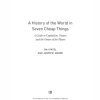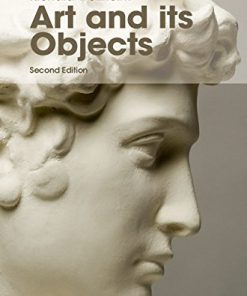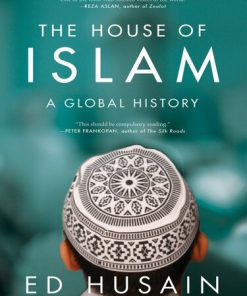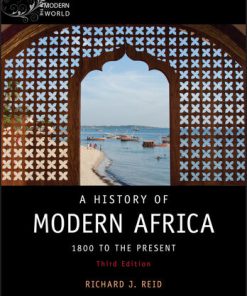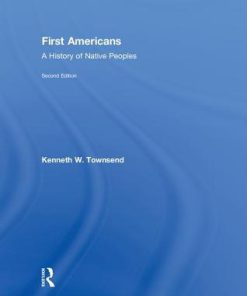The Earth and Its Peoples A Global History 7th Edition by Richard Bulliet 9781337401470 1337401471
$50.00 Original price was: $50.00.$25.00Current price is: $25.00.
The Earth and Its Peoples A Global History 7th Edition by Richard Bulliet – Ebook PDF Instant Download/Delivery: 9781337401470, 1337401471
Full download The Earth and Its Peoples A Global History 7th Edition after payment
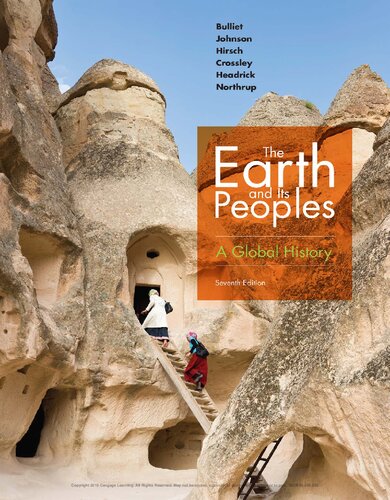
Product details:
• ISBN 10:1337401471
• ISBN 13:9781337401470
• Author:Richard Bulliet
The Earth and Its Peoples: A Global History
Featuring a beautiful new design, THE EARTH AND ITS PEOPLES, 7th Edition, presents world history in a balanced, global framework, shifting the focus away from political centers of power and toward the living conditions and activities of ordinary people. This truly global world history book employs a fundamental theme — the interaction of human beings and the environment — to compare different times, places, and societies. Special emphasis is given to technology (in its broadest sense) and how technological development underlies all human activity.
The Earth and Its Peoples A Global History 7th Table of contents:
Part I. The Emergence of Human Communities, to 500 BCE
Chapter 1. Nature, Humanity, and History, to 3500 BCE
1-1. African Genesis
1-1a. Interpreting the Evidence
1-1b. Human Evolution
1-1c. Migrations from Africa
1-2. Technology and Culture in the Ice Age
1-2a. Food Gathering and Stone Tools
1-2b. Gender Roles and Social Life
1-2c. Hearths and Cultural Expressions
1-3. The Agricultural Revolutions
1-3a. The Transition to Plant Cultivation
1-3b. Domesticated Animals and Pastoralism
1-3c. Agriculture and Ecological Crisis
1-4. Life in Neolithic Communities
1-4a. The Triumph of Food Producers
1-4b. Cultural Expressions
1-4c. Early Towns and Specialists
1-5. Conclusion
Key Terms
Review Questions
Chapter 2. The First River-Valley Civilizations, 3500–1500 BCE
2-1. Mesopotamia
2-1a. Settled Agriculture in an Unstable Landscape
2-1b. Sumerians and Semites
2-1c. Cities, Kings, and Trade
2-1d. Mesopotamian Society
2-1e. Gods, Priests, and Temples
2-1f. Technology and Science
2-2. Egypt
2-2a. The Land of Egypt: “Gift of the Nile”
2-2b. Divine Kingship
2-2c. Administration and Communication
2-2d. The People of Egypt
2-2e. Belief and Knowledge
2-3. The Indus Valley Civilization
2-3a. Natural Environment
2-3b. Material Culture
2-3c. Transformation of the Indus Valley Civilization
2-4. Conclusion
Key Terms
Review Questions
Chapter 3. The Mediterranean and Middle East, 2000–500 BCE
3-1. The Cosmopolitan Middle East, 1700–1100 BCE
3-1a. Western Asia
3-1b. New Kingdom Egypt
3-1c. Commerce and Communication
3-2. The Aegean World, 2000–1100 BCE
3-2a. Minoan Crete
3-2b. Mycenaean Greece
3-2c. The Fall of Late Bronze Age Civilizations
3-3. The Assyrian Empire, 911–612 BCE
3-3a. God and King
3-3b. Conquest and Control
3-3c. Assyrian Society and Culture
3-4. Israel, 2000–500 BCE
3-4a. Origins, Exodus, and Settlement
3-4b. Rise of the Monarchy
3-4c. Fragmentation and Dispersal
3-5. Phoenicia and the Mediterranean,1200–500 BCE
3-5a. The Phoenician City-States
3-5b. Expansion into the Mediterranean
3-5c. Carthage’s Commercial Empire
3-5d. War and Religion
3-6. Failure and Transformation, 750–550 BCE
3-7. Conclusion
Key Terms
Review Questions
Chapter 4. New Civilizations Outside the West Asian Core Area, 2300 BCE–350 CE
4-1. Early China, 2000–221 BCE
4-1a. Geography and Resources
4-1b. The Late Neolithic: Artifacts and Legends
4-1c. The Shang Period, 1766–1045 BCE
4-1d. The Zhou Period, 1045–221 BCE
4-1e. Confucianism, Daoism, and Chinese Society
4-1f. The Warring States Period, 481–221 BCE
4-2. Nubia, 2300 BCE–350 CE
4-2a. Early Cultures and Egyptian Domination, 2300–1100 BCE
4-2b. The Kingdom of Meroë, 800 BCE–350 CE
4-3. Pastoral Nomads of the Eurasian Steppes, 1000–100 BCE
4-3a. Early Nomadism
4-3b. Steppe Nomads
4-3c. The Scythians
4-3d. China and the Nomads
4-4. Celtic Europe, 1000–50 BCE
4-4a. The Spread of the Celts
4-4b. Celtic Society
4-4c. Belief and Knowledge
4-5. Conclusion
Environment and Organization
Religion and Power
A Tale of Two Hemispheres
Key Terms
Review Questions
Material Culture: Wine and Beer in the Ancient World
Issues in World History: Animal Domestication
Part II. The Formation of New Cultural Communities, 1000 BCE–400 CE
Chapter 5. Greece and Iran, 1000–30 BCE
5-1. Ancient Iran, 1000–500 BCE
5-1a. Geography and Resources
5-1b. The Rise of the Persian Empire
5-1c. Imperial Organization
5-1d. Ideology and Religion
5-2. The Rise of the Greeks, 1000–500 BCE
5-2a. Geography and Resources
5-2b. The Emergence of the Polis
5-2c. New Intellectual Currents
5-2d. Athens and Sparta
5-3. The Struggle of Persia and Greece, 546–323 BCE
5-3a. Early Encounters
5-3b. The Height of Athenian Power
5-3c. Inequality in Classical Greece
5-3d. Failure of the City-State and Triumph of the Macedonians
5-4. The Hellenistic Synthesis, 323–30 BCE
5-5. Conclusion
Key Terms
Review Questions
Chapter 6. An Age of Empires: Rome and Han China, 753 BCE–330 CE
6-1. Rome’s Creation of a Mediterranean Empire, 753 BCE–330 CE
6-1a. A Republic of Farmers, 753–31 BCE
6-1b. Expansion in Italy and the Mediterranean
6-1c. The Failure of the Republic
6-1d. The Roman Principate, 31 BCE–330 CE
6-1e. An Urban Empire
6-1f. The Rise of Christianity
6-1g. Technology and Transformation
6-2. The Origins of Imperial China, 221 BCE–220 CE
6-2a. The Qin Unification of China, 221–206 BCE
6-2b. The Long Reign of the Han, 202 BCE–220 CE
6-2c. Chinese Society
6-2d. New Forms of Thought and Belief
6-2e. Decline of the Han
6-3. Conclusion
Key Terms
Review Questions
Chapter 7. India and Southeast Asia, 1500 BCE–1025 CE
7-1. Foundations of Indian Civilization, 1500 BCE–300 CE
7-1a. The Indian Subcontinent
7-1b. The Vedic Age
7-1c. Challenges to the Old Order: Jainism and Buddhism
7-1d. The Evolution of Hinduism
7-2. Imperial Expansion and Collapse, 324 BCE–650 CE
7-2a. The Mauryan Empire, 324–184 BCE
7-2b. Commerce and Culture in an Era of Political Fragmentation
7-2c. The Gupta Empire, 320–550 CE
7-3. Southeast Asia, 50–1025 CE
7-3a. Early Civilization
7-3b. The Srivijayan Kingdom
7-4. Conclusion
Key Terms
Review Questions
Chapter 8. Peoples and Civilizations of the Americas, from 1200 BCE
8-1. Formative Civilizations of the Olmec and Chavín, 1200–200 BCE
8-1a. The Mesoamerican Olmec, 1200–400 BCE
8-1b. Early South American Civilization: Chavín, 900–200 BCE
8-2. Classic-Era Culture and Society in Mesoamerica, 200–900
8-2a. Teotihuacan
8-2b. The Maya
8-3. The Postclassic Period in Mesoamerica, 900–1300
8-3a. The Toltecs
8-3b. Cholula
8-4. Northern Peoples
8-4a. Southwestern Desert Cultures
8-4b. Mound Builders: The Hopewell and Mississippian Cultures
8-5. Andean Civilizations, 200–1400
8-5a. Cultural Response to Environmental Challenge
8-5b. The Early Intermediate Period Moche
8-5c. Tiwanaku and Wari
8-5d. Chimú
8-6. Conclusion
Key Terms
Review Questions
Material Culture: Bells, Gongs, and Drums
Issues in World History: Oral Societies and the Consequences of Literacy
Part III. Growth and Interaction of Cultural Communities, 300 BCE–1200 CE
Chapter 9. Networks of Communication and Exchange, 300 BCE–1100 CE
9-1. The Silk Road
9-1a. Iranians and Chinese
9-1b. Silk and New Crops
9-1c. Nomadism in Central and Inner Asia
9-1d. The Impact of the Silk Road
9-1e. Warriors and Missionaries
9-2. The Indian Ocean Maritime System
9-2a. Sailors’ Tales
9-2b. Ship Design
9-2c. Origins of Contact and Trade
9-2d. Indonesians in Madagascar
9-2e. The Impact of Indian Ocean Trade
9-2f. Incense, Ivory, and Pottery
9-2g. Western Ports
9-2h. Eastern Ports
9-3. Routes Across the Sahara
9-3a. Early Saharan Cultures
9-3b. Rock Paintings
9-3c. The Coming of the Camel
9-3d. Trade Across the Sahara
9-4. Sub-Saharan Africa
9-4a. A Challenging Geography
9-4b. The Development of Cultural Unity
9-4c. Economies and Social Practices
9-4d. An Isolated World
9-4e. African Cultural Characteristics
9-4f. Migration from an Expanding Desert
9-4g. The Advent of Iron and the Bantu Migrations
9-4h. Early Metalworking
9-4i. Linguistic Relations
9-5. The Spread of Ideas
9-5a. Ideas and Material Evidence
9-5b. Domestic Pigs
9-5c. The Spread of Buddhism
9-5d. Two Kings: Ashoka and Kanishka
9-5e. The Spread of Christianity
9-6. Conclusion
Key Terms
Review Questions
Chapter 10. The Sasanid Empire and the Rise of Islam, 200–1200
10-1. The Sasanid Empire, 224–651
10-1a. Politics and Society
10-1b. Religion and Empire
10-2. The Origins of Islam
10-2a. The Arabian Peninsula Before Muhammad
10-2b. Muhammad in Mecca and Medina
10-2c. Formation of the Umma
10-2d. Succession to Muhammad
10-3. The Rise and Fall of the Caliphate, 632–1258
10-3a. The Islamic Conquests, 634–711
10-3b. The Umayyad and Early Abbasid Caliphates, 661–850
10-3c. Political Fragmentation, 850–1050
10-3d. Assault from Within and Without, 1050–1258
10-4. Islamic Civilization
10-4a. Law and Dogma
10-4b. Converts and Cities
10-4c. Women and Islam
10-4d. Marginal Communities
10-4e. The Recentering of Islam
10-5. Conclusion
Key Terms
Review Questions
Chapter 11. Christian Societies Emerge in Europe, 600–1200
11-1. The Byzantine Empire, 600–1200
11-1a. An Empire Beleaguered
11-1b. Society and Urban Life
11-1c. Cultural Achievements
11-2. Early Medieval Europe, 600–1000
11-2a. The Time of Insecurity
11-2b. A Self-Sufficient Economy
11-2c. Early Medieval Society in the West
11-3. The Western Church
11-3a. Politics and the Church
11-3b. Monasticism
11-4. Kievan Russia, 900–1200
11-4a. The Rise of the Kievan Empire
11-4b. Society and Culture
11-5. Western Europe Revives, 1000–1200
11-5a. The Role of Technology
11-5b. Cities and the Rebirth of the Trade
11-6. The Crusades, 1095–1204
11-6a. The Roots of the Crusades
11-6b. The Impact of the Crusades
11-7. Conclusion
Key Terms
Review Questions
Chapter 12. Central and East Asia, 400–1200
12-1. The Sui and Tang Empires, 581–755
12-1a. Chang’an: Metropolis at the Center of East Asia
12-1b. Buddhism and the Tang Empire
12-1c. Upheavals and Repression, 750–879
12-1d. The End of the Tang Empire, 879–907
12-2. China and Its Rivals
12-2a. The Liao and Jin Challenge
12-2b. Song Industries
12-2c. Economy and Society in Song China
12-3. New Kingdoms in East Asia
12-3a. Chinese Influences
12-3b. Korea
12-3c. Japan
12-3d. Vietnam
12-4. Conclusion
Key Terms
Review Questions
Material Culture: Salt
Issues in World History: Religious Conversion
Part IV. Interregional Patterns of Culture and Contact, 1200–1550
Chapter 13. Mongol Eurasia and Its Aftermath, 1200–1500
13-1. The Rise of the Mongols, 1200–1260
13-1a. Nomadism in Central Asia
13-1b. The Mongol Conquests, 1215–1283
13-1c. Overland Trade and Disease
13-2. The Mongols and Islam, 1260–1500
13-2a. Mongol Rivalry
13-2b. Islam and the State
13-2c. Culture and Science in Islamic Eurasia
13-3. Regional Responses in Western Eurasia
13-3a. Russia and Rule from Afar
13-3b. New States in Eastern Europe and Anatolia
13-4. Mongol Domination in China, 1271–1368
13-4a. The Yuan Empire, 1271–1368
13-4b. The Fall of the Yuan Empire
13-5. The Early Ming Empire, 1368–1500
13-5a. Ming China on a Mongol Foundation
13-5b. Technology and Population
13-5c. The Ming Achievement
13-6. Centralization and Militarism in East Asia, 1200–1500
13-6a. Korea from the Mongols to the Choson Dynasty, 1231–1500
13-6b. Political Transformation in Japan, 1274–1500
13-6c. The Emergence of Vietnam, 1200–1500
13-7. Conclusion
Key Terms
Review Questions
Chapter 14. Latin Europe, 1200–1500
14-1. Rural Growth and Crisis
14-1a. Peasants, Population, and Plague
14-1b. Social Rebellion
14-1c. Mills and Mines
14-2. Urban Revival
14-2a. Trading Cities
14-2b. Civic Life
14-2c. Gothic Cathedrals
14-3. Learning, Literature, and the Renaissance
14-3a. The Renaissance
14-3b. Humanists and Printers
14-3c. Renaissance Artists
14-4. Political and Military Transformations
14-4a. Monarchs, Nobles, and the Church
14-4b. The Hundred Years’ War
14-4c. New Monarchies in France and England
14-4d. Iberian Unification
14-4e. The Ottoman Frontier
14-4f. Christian Responses
14-5. Conclusion
Key Terms
Review Questions
Chapter 15. Southern Empires, Southern Seas, 1200–1500
15-1. Tropical Africa and Asia
15-1a. Tropical Environments
15-1b. Human Ecosystems
15-1c. Water Systems and Irrigation
15-1d. Mineral Resources
15-2. New Islamic Empires
15-2a. Mali in the Western Sudan
15-2b. The Delhi Sultanate in India
15-3. Indian Ocean Trade
15-3a. Monsoon Mariners
15-3b. Africa: The Swahili Coast and Zimbabwe
15-3c. Arabia: Aden and the Red Sea
15-3d. India: Gujarat and the Malabar Coast
15-3e. Southeast Asia
15-4. Social and Cultural Change
15-4a. Architecture, Learning, and Religion
15-4b. Social and Gender Distinctions
15-5. The Western Hemisphere
15-5a. Mesoamerica: The Aztecs
15-5b. The Andes: The Inka
15-6. Conclusion
Key Terms
Review Questions
Chapter 16. The Maritime Revolution, to 1550
16-1. Global Maritime Expansion Before 1450
16-1a. The Indian Ocean
16-1b. The Pacific Ocean
16-1c. The Atlantic Ocean
16-2. European Expansion, 1400–1550
16-2a. Motives for Exploration
16-2b. Portuguese Voyages
16-2c. Spanish Voyages
16-3. Encounters with Europe, 1450–1550
16-3a. Western Africa
16-3b. Eastern Africa
16-3c. Indian Ocean States
16-3d. The Americas
16-4. Conclusion
Key Terms
Review Questions
Material Culture: Head Coverings
Issues in World History: Climate and Population to 1500
Part V. The Globe Encompassed, 1500–1750
Chapter 17. Transformations in Europe, 1500–1750
17-1. Culture and Ideas
17-1a. Early Reformation
17-1b. The Counter-Reformation and the Politics of Religion
17-1c. Local Religion, Traditional Culture, and Witch-Hunts
17-1d. The Scientific Revolution
17-1e. The Early Enlightenment
17-2. Social and Economic Life
17-2a. The Bourgeoisie
17-2b. Peasants and Laborers
17-2c. Women and the Family
17-3. Political Innovations
17-3a. State Development
17-3b. The Monarchies of England and France
17-3c. Warfare and Diplomacy
17-3d. Paying the Piper
17-4. Conclusion
Key Terms
Review Questions
Chapter 18. The Diversity of American Colonial Societies, 1530–1770
18-1. The Columbian Exchange
18-1a. Demographic Changes
18-1b. Transfer of Plants and Animals
18-2. Spanish America and Brazil
18-2a. State and Church
18-2b. Colonial Economies
18-2c. Society in Colonial Latin America
18-3. English and French Colonies in North America
18-3a. Early English Experiments
18-3b. The South
18-3c. New England
18-3d. The Middle Atlantic Region
18-3e. French America
18.4. Colonial Expansion and Conflict
18-4a. Imperial Reform in Spanish America and Brazil
18-4b. Reform and Reorganization in British America
18-5. Conclusion
Key Terms
Review Questions
Chapter 19. The Atlantic System and Africa, 1550–1800
19-1. Plantations in the West Indies
19-1a. Colonization Before 1650
19-1b. Sugar and Slaves
19-2. Plantation Life in the Eighteenth Century
19-2a. Technology and Environment
19-2b. Slaves’ Lives
19-2c. Free Whites and Free Blacks
19-3. Creating the Atlantic Economy
19-3a. Capitalism and Mercantilism
19-3b. The Atlantic Circuit
19-4. Africa, the Atlantic, and Islam
19-4a. The Gold Coast and the Slave Coast
19-4b. The Bight of Biafra and Angola
19-4c. Africa’s European and Islamic Contacts
19-5. Conclusion
Key Terms
Review Questions
Chapter 20. Between Europe and China, 1500–1750
20-1. The Ottoman Empire, to 1750
20-1a. Expansion and Frontiers
20-1b. Central Institutions
20-1c. Crisis of the Military State, 1585–1650
20-1d. Economic Change and Growing Weakness
20-2. The Safavid Empire, 1502–1722
20-2a. Safavid Society and Religion
20-2b. A Tale of Two Cities: Isfahan and Istanbul
20-2c. Economic Crisis and Political Collapse
20-3. The Mughal Empire, 1526–1739
20-3a. Political Foundations
20-3b. Hindus and Muslims
20-3c. Central Decay and Regional Challenges
20-4. The Russian Empire, 1500–1725
20-4a. The Drive Across Northern Asia
20-4b. Russian Society and Politics to 1725
20-4c. Peter the Great
20-5. The Maritime Worlds of Islam, 1500–1750
20-5a. Muslims in Southeast Asia
20-5b. Muslims in Coastal Africa
20-5c. European Powers in Southern Seas
20-6. Conclusion
Key Terms
Review Questions
Chapter 21. East Asia in Global Perspective
21-1. East Asia and Europe
21-1a. Trading Companies and Missionaries
21-1b. Chinese Influences on Europe
21-1c. Japan and the Europeans
21-2. The Imjin War and Japanese Unification
21-3. Tokugawa Japan and Choson Korea to 1800
21-3a. Japanese Reunification and Economic Growth
21-3b. Japanese Elite Decline and Social Crisis
21-3c. Choson Korea
21-4. From Ming to Qing
21-4a. Ming Economic Growth, 1500–1644
21-4b. Ming Collapse and the Rise of the Qing
21-4c. Emperor Kangxi
21-4d. Tea and Diplomacy
21-4e. Population Growth and Environmental Stress
21-5. Conclusion
Key Terms
Review Questions
Material Culture: Four-Wheeled Vehicles
Issues in World History: The Little Ice Age
Part VI. Revolutions Reshape the World, 1750–1870
Chapter 22. The Early Industrial Revolution, 1760–1851
22-1. Causes of the Industrial Revolution
22-1a. Population Growth
22-1b. The Agricultural Revolution
22-1c. Trade and Inventiveness
22-1d. Britain and Continental Europe
22-2. The Technological Revolution
22-2a. Mass Production: Pottery
22-2b. Mechanization: The Cotton Industry
22-2c. The Iron Industry
22-2d. The Steam Engine
22-2e. Railroads
22-2f. Communication over Wires
22-3. The Impact of the Early Industrial Revolution
22-3a. The New Industrial Cities
22-3b. Rural Environments
22-3c. Working Conditions
22-3d. Changes in Society
22-4. New Economic and Political Ideas
22-4a. Laissez Faire and Its Critics
22-4b. Protests and Reforms
22-5. The Limits of Industrialization Outside the West
22-5a. Egypt
22-5b. India
22-5c. China
22-6. Conclusion
Key Terms
Review Questions
Chapter 23. Revolutionary Changes in the Atlantic World, 1750–1850
23-1. Prelude to Revolution: The Eighteenth-Century Crisis
23-1a. Colonial Wars and Fiscal Crises
23-1b. The Enlightenment and the Old Order
23-1c. Folk Cultures and Popular Protest
23-2. The American Revolution, 1775–1800
23-2a. Frontiers and Taxes
23-2b. The Course of Revolution, 1775–1783
23-2c. The Construction of Republican Institutions, to 1800
23-3. The French Revolution, 1789–1815
23-3a. French Society and Fiscal Crisis
23-3b. Protest Turns to Revolution, 1789–1792
23-3c. The Terror, 1793–1794
23-3d. Reaction and the Rise of Napoleon, 1795–1815
23-4. Revolution Spreads, Conservatives Respond, 1789–1850
23-4a. The Haitian Revolution, 1789–1804
23-4b. The Congress of Vienna and Conservative Retrenchment, 1815–1820
23-4c. Nationalism, Reform, and Revolution, 1821–1850
23-5. Conclusion
Key Terms
Review Questions
Chapter 24. Land Empires in the Age of Imperialism, 1800–1870
24-1. The Ottoman Empire
24-1a. Egypt and the Napoleonic Example
24-1b. Ottoman Reform and the European Model, 1807–1853
24-1c. The Crimean War and Its Aftermath
24-2. The Russian Empire
24-2a. Russia and Europe
24-2b. Russia and Asia
24-2c. Cultural Trends
24-3. The Qing Empire
24-3a. Economic and Social Disorder
24-3b. The Opium War and Its Aftermath, 1839–1850
24-3c. The Taiping Rebellion, 1850–1864
24-3d. Decentralization at the End of the Qing Empire, 1864–1875
24-4. Conclusion
Key Terms
Review Questions
Chapter 25. Nation Building and Economic Transformation in the Americas, 1800–1890
25-1. Independence in Latin America, 1800–1830
25-1a. Roots of Revolution, to 1810
25-1b. Spanish South America, 1810–1825
25-1c. Mexico, 1810–1823
25-1d. Brazil, to 1831
25-2. The Problem of Order, 1825–1890
25-2a. Constitutional Experiments
25-2b. Personalist Leaders
25-2c. The Threat of Regionalism
25-2d. Foreign Interventions and Regional Wars
25-2e. Native Peoples and the Nation-State
25-3. The Challenge of Social and Economic Change
25-3a. The Abolition of Slavery
25-3b. Immigration
25-3c. American Cultures
25-3d. Women’s Rights and the Struggle for Social Justice
25-3e. Development and Underdevelopment
25-3f. Altered Environments
25-4. Conclusion
Key Terms
Review Questions
Material Culture: Cotton Clothing
Issues in World History: State Power, the Census, and the Question of Identity
Part VII. Global Diversity and Dominance, 1750–1945
Chapter 26. Varieties of Imperialism in Africa, India, Southeast Asia, and Latin America, 1750–1914
26-1. Changes and Exchanges in Africa
26-1a. Southern Africa
26-1b. West and Equatorial Africa
26-1c. The Berlin Conference
26-1d. Modernization in Egypt and Ethiopia
26-1e. Transition from the Slave Trade
26-1f. Secondary Empire in Eastern Africa
26-2. India Under British Rule
26-2a. East India Company
26-2b. Political Reform and Industrial Impact
26-2c. Indian Nationalism
26-3. Southeast Asia and the Pacific
26-3a. Australia
26-3b. New Zealand
26-3c. Hawaii and the Philippines, 1878–1902
26-4. Imperialism in Latin America
26-4a. American Expansionism and the Spanish-American War, 1898
26-4b. Economic Imperialism
26-4c. Revolution and Civil War in Mexico
26-4d. American Intervention in the Caribbean and Central America, 1901–1914
26-5. The World Economy and the Global Environment
26-5a. Expansion of the World Economy
26-5b. Free Trade
26-5c. New Labor Migrations
26-6. Conclusion
Key Terms
Review Questions
Chapter 27. The New Power Balance, 1850–1900
27-1. New Technologies and the World Economy
27-1a. Railroads
27-1b. Steamships and Telegraph Cables
27-1c. The Steel and Chemical Industries
27-1d. Environmental Problems
27-1e. Electricity
27-1f. World Trade and Finance
27-2. Social Changes
27-2a. Population and Migration
27-2b. Urbanization and Urban Environments
27-2c. Middle-Class Women’s “Separate Sphere”
27-2d. Working-Class Women
27-3. Socialism and Labor Movements
27-3a. Revolutionary Alternatives
27-3b. Labor Unions and Movements
27-4. Nationalism and the Rise of Italy, Germany, and Japan
27-4a. Language and National Identity in Europe Before 1871
27-4b. The Unification of Italy, 1860–1870
27-4c. The Unification of Germany, 1866–1871
27-4d. The West Challenges Japan
27-4e. The Meiji Restoration and the Modernization of Japan, 1868–1894
27-4f. Nationalism and Social Darwinism
27-5. The Great Powers of Europe, 1871–1900
27-5a. Germany at the Center of Europe
27-5b. The Liberal Powers: France and Great Britain
27-5c. The Conservative Powers: Russia and Austria-Hungary
27-6. China, Japan, and the Western Powers
27-6a. China in Turmoil
27-6b. Japan Confronts China
27-7. Conclusion
Key Terms
Review Questions
Chapter 28. The Crisis of the Imperial Order, 1900–1929
28-1. Origins of the Crisis in Europe and the Middle East
28-1a. The Ottoman Empire and the Balkans
28-1b. Nationalism, Alliances, and Military Strategy
28-2. The “Great War” and the Russian Revolutions, 1914–1918
28-2a. Stalemate, 1914–1917
28-2b. The Home Front and the War Economy
28-2c. The Ottoman Empire at War
28-2d. Double Revolution in Russia
28-2e. The End of the War in Western Europe, 1917–1918
28-3. Peace and Dislocation in Europe, 1919–1929
28-3a. The Impact of the War
28-3b. The Peace Treaties
28-3c. Russian Civil War and the New Economic Policy
28-3d. An Ephemeral Peace
28-4. China and Japan: Contrasting Destinies
28-4a. Social and Economic Change
28-4b. Revolution and War, 1900–1918
28-4c. Chinese Warlords and the Guomindang, 1919–1929
28-5. The New Middle East
28-5a. The Mandate System
28-5b. The Rise of Modern Turkey
28-5c. Arab Lands and the Question of Palestine
28-6. Conclusion
Key Terms
Review Questions
Chapter 29. The Collapse of the Old Order, 1929–1949
29-1. The Stalin Revolution
29-1a. Five-Year Plans
29-1b. Collectivization of Agriculture
29-1c. Terror and Opportunities
29-2. The Depression
29-2a. Economic Crisis
29-2b. Depression in Industrial Nations
29-2c. Depression in Nonindustrial Regions
29-3. The Rise of Fascism
29-3a. Mussolini’s Italy
29-3b. Hitler’s Germany
29-3c. The Road to War, 1933–1939
29-4. East Asia, 1931–1945
29-4a. The Manchurian Incident of 1931
29-4b. The Long March
29-4c. The Sino-Japanese War, 1937–1945
29-5. The Second World War
29-5a. The War of Movement
29-5b. War in Europe and North Africa
29-5c. War in Asia and the Pacific
29-5d. The End of War
29-5e. Collapse of the Guomindang and Communist Victory
29-6. The Character of Warfare
29-6a. The Science and Technology of War
29-6b. Bombing Raids
29-6c. The Holocaust
29-6d. The Home Front in Europe and Asia
29-6e. The Home Front in the United States
29-6f. War and the Environment
29-7. Conclusion
Key Terms
Review Questions
Chapter 30. Revolutions in Living, 1900–1950
30-1. New Technology Outside the Industrialized World
30-1a. Urbanization
30-1b. Electricity
30-1c. New Media
30-2. New Ways of Living in The Industrialized World
30-2a. Identity
30-2b. Women’s Lives
30-2c. Revolution in the Sciences: The New Physics
30-2d. The New Social Sciences
30-2e. New Technologies and Activities
30-2f. Technology and the Environment
30-3. A New India, 1905–1947
30-3a. The Land and the People
30-3b. British Rule and Indian Nationalism
30-3c. Mahatma Gandhi and Militant Nonviolence
30-3d. India Moves Toward Independence
30-3e. Partition and Independence
30-4. Mexico, Argentina, and Brazil, 1917–1949
30-4a. The Cárdenas Reforms
30-4b. The Transformation of Argentina
30-4c. Brazil and Argentina, to 1929
30-4d. The Depression and the Vargas Regime in Brazil
30-4e. Argentina After 1930
30-5. Sub-Saharan Africa, 1900–1945
30-5a. Colonial Africa: Economic and Social Changes
30-5b. Religious and Political Changes
30-5c. Africa and the New Media
30-6. Conclusion
Key Terms
Review Questions
Material Culture: Roads
Issues in World History: Famines and Politics
Part VIII. Perils and Promises of a Global Community, 1945 to the Present
Chapter 31. The Cold War and Decolonization, 1945–1975
31-1. The Cold War
31-1a. The United Nations
31-1b. Capitalism and Communism
31-1c . West versus East in Europe and Korea
31-1d. The United States and Vietnam
31-1e. The Race for Nuclear Supremacy
31-2. Decolonization and Nation Building
31-2a. New Nations in South and Southeast Asia
31-2b. The Struggle for Independence in Africa
31-2c. The Quest for Economic Freedom in Latin America
31-3. Beyond a Bipolar World
31-3a. The Third World
31-3b. Japan and China
31-3c. The Middle East
31-3d. The Emergence of Environmental Concerns
31-4. Conclusion
Key Terms
Review Questions
Chapter 32. The End of the Cold War and the Challenge of Economic Development and Immigration, 1975–2000
32-1. Postcolonial Crises and Asian Economic Expansion
32-1a. Revolutions, Repression, and Democratic Reform in Latin America
32-1b. Islamic Revolutions in Iran and Afghanistan
32-1c. Asian Transformation
32-1d. China Rejoins the World Economy
32-2. The End of the Bipolar World
32-2a. Crisis in the Soviet Union
32-2b. The Collapse of the Socialist Bloc
32-2c. Africa in the Era of Global Political Change
32-2d. The Persian Gulf War
32-3. The Challenge of Population Growth
32-3a. Demographic Transition
32-3b. The Industrialized Nations
32-3c. The Developing Nations
32-3d. Old and Young Populations
32-4. Unequal Development and the Movement of Peoples
32-4a. The Problem of Inequality
32-4b. Internal Migration: The Growth of Cities
32-4c. Global Migration
32-5. Technological and Environmental Change
32-5a. New Technologies and the World Economy
32-5b. Conserving and Sharing Resources
32-5c. Responding to Environmental Threats
32-6. Conclusion
Key Terms
Review Questions
Chapter 33. Leaving the Twentieth Century
33-1. The Question of Values
33-1a. Faith and Politics
33-1b. Terrorism
33-1c. Regime Change in the Muslim World
33-1d. North Korea and Iran
33-1e. Hezbollah and Hamas
33-1f. Muslims and Violence
33-1g. Christians and Jews
33-1h. Universal Rights and Values
33-1i. Nongovernmental Organizations
33-1j. Women’s Rights
33-2. Globalization and Economic Crisis
33-2a. Global Financial Crisis
33-2b. Regional Trade Organizations
33-2c. World Trade Organization
33-2d. From Obama to Trump
33-2e. Globalization and Democracy
33-2f. Eastern Europe
33-2g. Democracy in Asia
32-2h. Instability in Pakistan and Turkey
33-2i. African Regimes
33-3. Global Culture
33-3a. The Media and the Message
33-3b. Global Communication
33-3c. The Spread of Popular Culture
33-3d. Emerging Global Elite Culture
33-3e. Global Science and University Education
33-3f. Enduring Cultural Diversity
33-4. Conclusion
Key Terms
Review Questions
Material Culture: Fast Food
Issues in World History: Popular Culture—Words of Warning
The Face of the Divine in World History: Creating a Museum Exhibit
Part I. Information for Instructors
Activity Overview
Pedagogical Goals
Tips for Instructors
Part II. Information for Students
Background
Instructions
Travel Brochure: The Silk Road
Part I. Information for Instructors
Activity Overview
Pedagogical Goals
Tips for Instructors
Selected Online Resources
Part II. Information for Students
Background
Instructions
Potential Topics
The Expanding Atlantic World: Creating an Historical Exhibit
Part I. Information for Instructors
Activity Overview
Pedagogical Goals
Sample
Tips for Instructors
Part II. Information for Students
Background
Activity Description
Witchcraft in World History: Creating a Historical Documentary
Part I. Information for Instructors
Activity Overview
Pedagogical Goals
Tips for Instructors
Sample Topic Segment List (not exclusive)
Part II. Information for Students
Background
Instructions
Questions for Students
Europe’s New Imperialism: A Class Debate
Part I. Information for Instructors
Pedagogical Goals
Activity Instructions
Part II. Information for Students
Background
Participants
Questions
Primary Sources
Conclusions
The Cold War: Interrogating Primary Sources
Part I. Information for Instructors
Pedagogical Goals
Activity Instructions
Discussion Question Set I
Discussion Question Set II
Part II. Information for Students
Instructions
Questions for Students
Primary Source Transcript
The Quest for Stability in Medieval Europe’s Period of Crisis, 800–1000: A Class Debate
Part I. Information for Instructors
Activity Overview
Pedagogical Goals
Tips for Instructors
Part II. Information for Students
Background
Activity Description
The Factors
Primary Sources
Survivor: Black Death
Part I. Information for Instructors
Activity Overview
Pedagogical Goals
Tips for Instructors
Part II. Information for Students
Background
Activity Description
The Strategic Plan
Villager Roles
The Decline of Rome: Creating an Investigative News Report
Part I. Information for Instructors
Activity Overview
Pedagogical Goals
Tips for Instructors
Part II. Information for Students
Background
Activity Description
Suggested Readings
Chapter 1. Nature, Humanity, and History, to 3500 BCE
Chapter 2. The First River-Valley Civilizations, 3500–1500 BCE
Chapter 3. The Mediterranean and Middle East, 2000–500 BCE
Chapter 4. New Civilizations Outside the West Asian Core Area, 2300 BCE–350 CE
Chapter 5. Greece and Iran, 1000–30 BCE
Chapter 6. An Age of Empires: Rome and Han China, 753 BCE–330 CE
Chapter 7. India and Southeast Asia, 1500 BCE–1025 CE
Chapter 8. Peoples and Civilizations of the Americas, from 1200 BCE
Chapter 9. Networks of Communication and Exchange, 300 BCE–1100 CE
Chapter 10. The Sasanid Empire and the Rise of Islam, 200–1200
Chapter 11. Christian Societies Emerge in Europe, 600–1200
Chapter 12. Central and East Asia, 400–1200
Chapter 13. Mongol Eurasia and Its Aftermath, 1200–1500
Chapter 14. Latin Europe, 1200–1500
Chapter 15. Southern Empires, Southern Seas, 1200–1500
Chapter 16. The Maritime Revolution, to 1550
Chapter 17. Transformations in Europe, 1500–1750
Chapter 18. The Diversity of American Colonial Societies, 1530–1770
Chapter 19. The Atlantic System and Africa, 1550–1800
Chapter 20. Between Europe and China, 1500–1750
Chapter 21. East Asia in Global Perspective
Chapter 22. The Early Industrial Revolution, 1760–1851
Chapter 23. Revolutionary Changes in the Atlantic World, 1750–1850
Chapter 24. Land Empires in the Age of Imperialism, 1800–1870
Chapter 25. Nation Building and Economic Transformation in the Americas, 1800–1890
Chapter 26. Varieties of Imperialism in Africa, India, Southeast Asia, and Latin America, 1750–1914
Chapter 27. The New Power Balance, 1850–1900
Chapter 28. The Crisis of the Imperial Order, 1900–1929
Chapter 29. The Collapse of the Old Order, 1929–1949
Chapter 30. Revolutions in Living, 1900–1950
Chapter 31. The Cold War and Decolonization, 1945–1975
Chapter 32. The End of the Cold War and the Challenge of Economic Development and Immigration, 1975–2000
Chapter 33. Leaving the Twentieth Century
People also search for The Earth and Its Peoples A Global History 7th:
the earth and its peoples
the earth and its peoples 7th edition pdf
the earth and its peoples 6th edition pdf
the earth and its peoples audiobook
the earth and its peoples 8th edition
You may also like…
Politics & Philosophy - Government & Politics
The House of Islam A Global History Ed Husain 1408872269 9781408872260
Medicine - Pharmacology
Chemistry - Chemistry - General & Miscellaneous
The Periodic Table – Its Story And Its Significance 2th Edition Scerri Eric 0190914386 9780190914387
Politics & Philosophy - Anthropology
Medicine - Pediatrics
Pediatric Secrets 7th Edition by Richard Polin,Mark Ditmar 9780323636650 0323636659
Politics & Philosophy - Social Sciences
History - African History
History - American Studies



